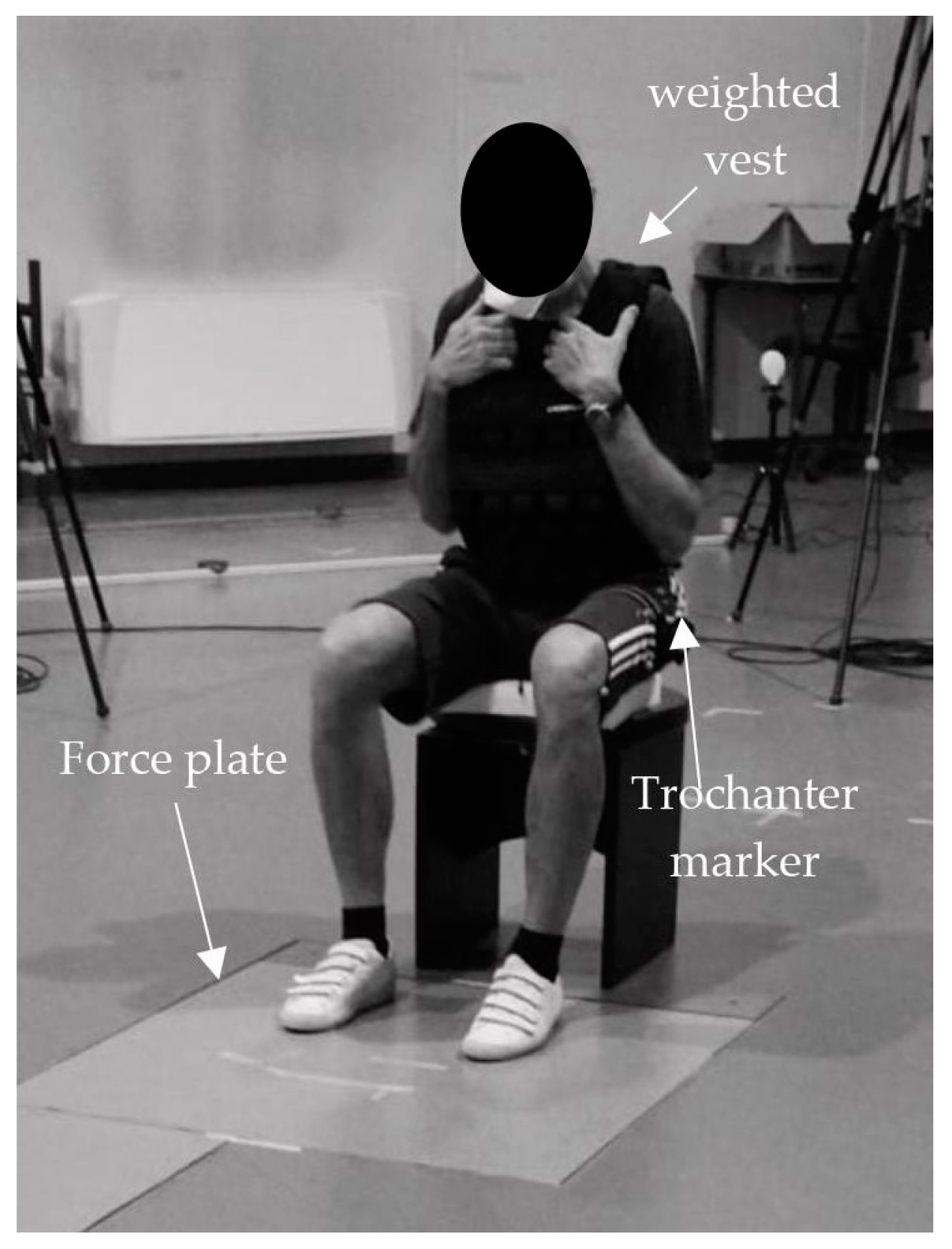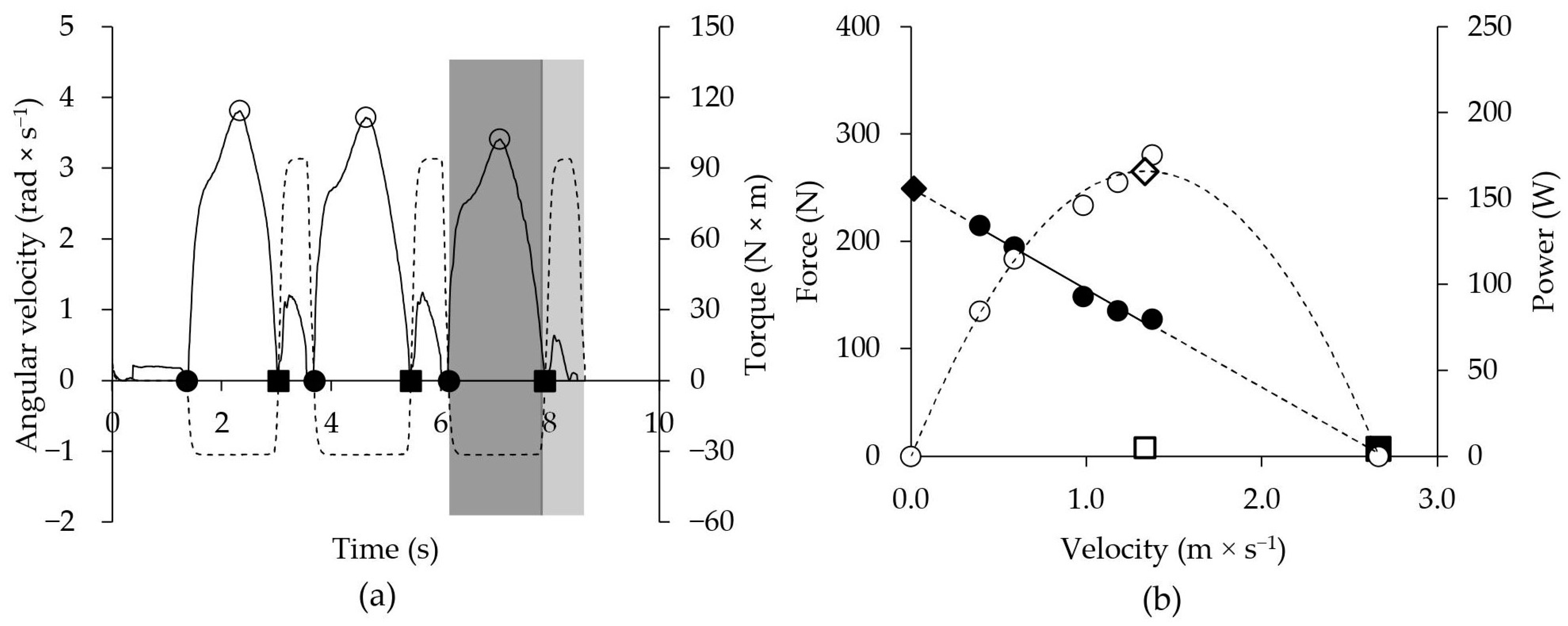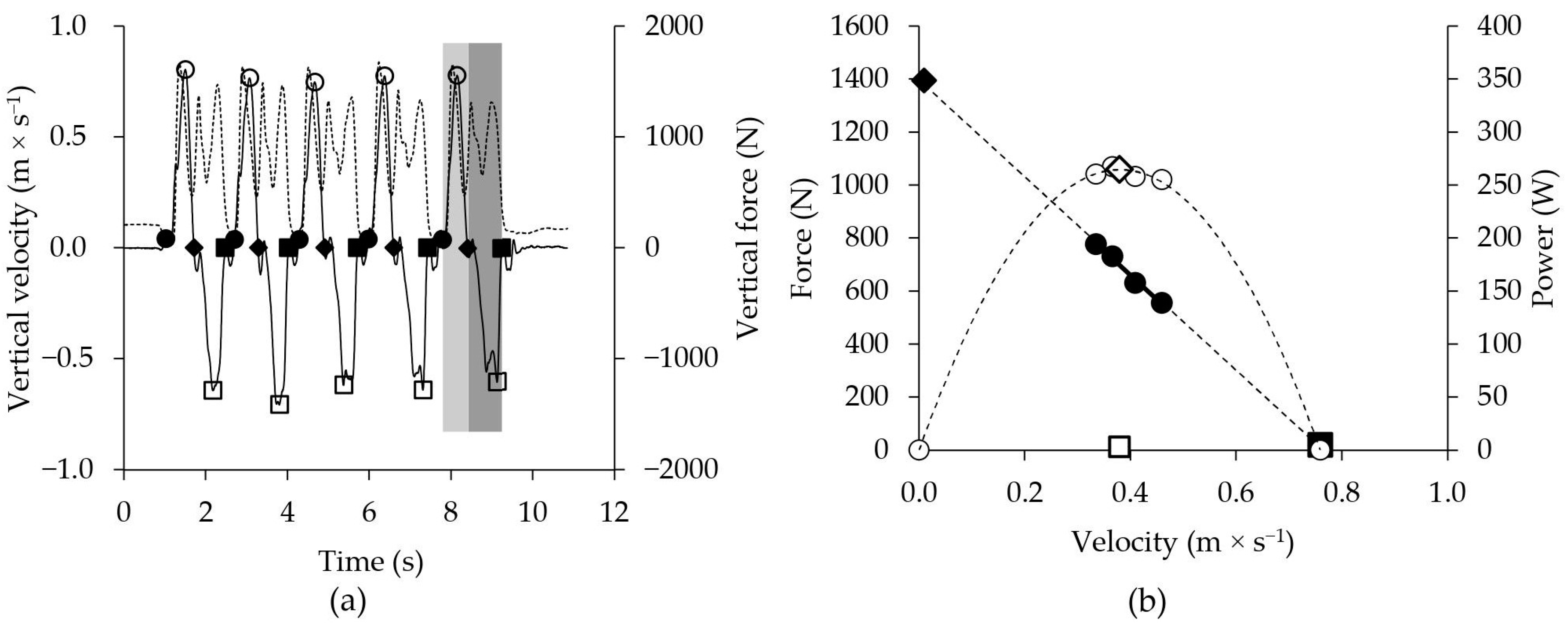Loaded 5 Sit-to-Stand Test to Determine the Force–Velocity Relationship in Older Adults: A Validation Study
Abstract
:1. Introduction
2. Materials and Methods
2.1. Participants
2.2. Study Procedures
2.3. Data Collection
2.3.1. Clinical Markers of Muscle Mass and Strength
2.3.2. Isokinetic Strength Test
2.3.3. STS Test
2.3.4. Adverse Events
2.4. Data Analysis
2.4.1. Clinical Markers of Muscle Mass and Strength
2.4.2. Isokinetic Strength Test
2.4.3. STS Test
2.5. Statistical Analysis
3. Results
4. Discussion
5. Conclusions
Author Contributions
Funding
Institutional Review Board Statement
Informed Consent Statement
Data Availability Statement
Conflicts of Interest
References
- Cawthon, P.M.; Visser, M.; Arai, H.; Ávila-Funes, J.A.; Barazzoni, R.; Bhasin, S.; Binder, E.; Bruyère, O.; Cederholm, T.; Chen, L.-K.; et al. Defining terms commonly used in sarcopenia research: A glossary proposed by the Global Leadership in Sarcopenia (GLIS) Steering Committee. Eur. Geriatr. Med. 2022, 13, 1239–1244. [Google Scholar] [CrossRef]
- Baltasar-Fernandez, I.; Alcazar, J.; Rodriguez-Lopez, C.; Losa-Reyna, J.; Alonso-Seco, M.; Ara, I.; Alegre, L.M. Sit-to-stand muscle power test: Comparison between estimated and force plate-derived mechanical power and their association with physical function in older adults. Exp. Gerontol. 2021, 145, 111213. [Google Scholar] [CrossRef] [PubMed]
- Crockett, K.; Ardell, K.; Hermanson, M.; Penner, A.; Lanovaz, J.; Farthing, J.; Arnold, C. The Relationship of Knee-Extensor Strength and Rate of Torque Development to Sit-to-Stand Performance in Older Adults. Physiother. Can. 2013, 65, 229–235. [Google Scholar] [CrossRef] [PubMed] [Green Version]
- Lindberg, K.; Lohne-Seiler, H.; Fosstveit, S.H.; Sibayan, E.E.; Fjeller, J.S.; Løvold, S.; Kolnes, T.; Vårvik, F.T.; Berntsen, S.; Paulsen, G.; et al. Effectiveness of individualized training based on force–velocity profiling on physical function in older men. Scand. J. Med. Sci. Sports 2022, 32, 1013–1025. [Google Scholar] [CrossRef] [PubMed]
- Muollo, V.; Rossi, A.P.; Zignoli, A.; Teso, M.; Milanese, C.; Cavedon, V.; Zamboni, M.; Schena, F.; Capelli, C.; Pogliaghi, S. Full characterisation of knee extensors’ function in ageing: Effect of sex and obesity. Int. J. Obes. 2021, 45, 895–905. [Google Scholar] [CrossRef]
- Rice, J.; Keogh, J. Power Training: Can It Improve Functional Performance in Older Adults? A Systematic Review. Int. J. Exerc. Sci. 2009, 2, 131–151. [Google Scholar]
- Takai, Y.; Ohta, M.; Akagi, R.; Kanehisa, H.; Kawakami, Y.; Fukunaga, T. Sit-to-stand Test to Evaluate Knee Extensor Muscle Size and Strength in the Elderly: A Novel Approach. J. Physiol. Anthr. 2009, 28, 123–128. [Google Scholar] [CrossRef] [Green Version]
- Yamauchi, J.; Mishima, C.; Nakayama, S.; Ishii, N. Force–velocity, force–power relationships of bilateral and unilateral leg multi-joint movements in young and elderly women. J. Biomech. 2009, 42, 2151–2157. [Google Scholar] [CrossRef]
- Cruz-Jentoft, A.J.; Sayer, A.A. Sarcopenia. Lancet 2019, 393, 2636–2646. [Google Scholar] [CrossRef]
- Alcazar, J.; Rodriguez-Lopez, C.R.; Ara, I.; Alfaro-Acha, A.; Manas-Bote, A.M.; Guadalupe-Grau, A.; Garcia-Garcia, F.J.; Alegre, L.M. The Force-Velocity Relationship in Older People: Reliability and Validity of a Systematic Procedure. Int. J. Sports Med. 2017, 38, 1097–1104. [Google Scholar] [CrossRef]
- Alcazar, J.; Rodriguez-Lopez, C.; Ara, I.; Alfaro-Acha, A.; Rodríguez-Gómez, I.; Navarro-Cruz, R.; Losa-Reyna, J.; García-García, F.J.; Alegre, L.M. Force-velocity profiling in older adults: An adequate tool for the management of functional trajectories with aging. Exp. Gerontol. 2018, 108, 1–6. [Google Scholar] [CrossRef]
- Piche, E.; Chorin, F.; Gerus, P.; Jaafar, A.; Reneaud, N.; Guerin, O.; Zory, R. Validity of a simple sit-to-stand method for assessing force-velocity profile in older adults. Exp. Gerontol. 2021, 156, 111595. [Google Scholar] [CrossRef]
- Lindemann, U.; Claus, H.; Stuber, M.; Augat, P.; Muche, R.; Nikolaus, T.; Becker, C. Measuring power during the sit-to-stand transfer. Eur. J. Appl. Physiol. 2003, 89, 466–470. [Google Scholar] [CrossRef]
- Alcazar, J.; Losa-Reyna, J.; Lopez, C.R.; Alfaro-Acha, A.; Rodriguez-Mañas, L.; Ara, I.; García-García, F.J.; Alegre, L.M. The sit-to-stand muscle power test: An easy, inexpensive and portable procedure to assess muscle power in older people. Exp. Gerontol. 2018, 112, 38–43. [Google Scholar] [CrossRef]
- Baltasar-Fernandez, I.; Alcazar, J.; Mañas, A.; Alegre, L.M.; Alfaro-Acha, A.; Rodriguez-Mañas, L.; Ara, I.; García-García, F.J.; Losa-Reyna, J. Relative sit-to-stand power cut-off points and their association with negatives outcomes in older adults. Sci. Rep. 2021, 11, 19460. [Google Scholar] [CrossRef] [PubMed]
- Thomas, K.; Brownstein, C.G.; Dent, J.; Parker, P.; Goodall, S.; Howatson, G. Neuromuscular Fatigue and Recovery after Heavy Resistance, Jump, and Sprint Training. Med. Sci. Sports Exerc. 2018, 50, 2526–2535. [Google Scholar] [CrossRef] [PubMed] [Green Version]
- Nana, A.; Slater, G.J.; Stewart, A.D.; Burke, L.M. Methodology Review: Using Dual-Energy X-Ray Absorptiometry (DXA) for the Assessment of Body Composition in Athletes and Active People. Int. J. Sport Nutr. Exerc. Metab. 2015, 25, 198–215. [Google Scholar] [CrossRef] [Green Version]
- Sousa-Santos, A.R.; Amaral, T.F. Differences in handgrip strength protocols to identify sarcopenia and frailty—A systematic review. BMC Geriatr. 2017, 17, 238. [Google Scholar] [CrossRef] [Green Version]
- Ferrari, L.; Bochicchio, G.; Bottari, A.; Lucertini, F.; Scarton, A.; Pogliaghi, S. Estimating Muscle Power of the Lower Limbs through the 5-Sit-to-Stand Test: A Comparison of Field vs. Laboratory Method. Appl. Sci. 2022, 12, 11577. [Google Scholar] [CrossRef]
- Grbic, V.; Djuric, S.; Knezevic, O.M.; Mirkov, D.M.; Nedeljkovic, A.; Jaric, S. A Novel Two-Velocity Method for Elaborate Isokinetic Testing of Knee Extensors. Int. J. Sports Med. 2017, 38, 741–746. [Google Scholar] [CrossRef]
- Jaric, S. Force-velocity Relationship of Muscles Performing Multi-joint Maximum Performance Tasks. Int. J. Sports Med. 2015, 36, 699–704. [Google Scholar] [CrossRef]
- Bochicchio, G.; Ferrari, L.; Bottari, A.; Lucertini, F.; Scarton, A.; Pogliaghi, S. Temporal, Kinematic and Kinetic Variables Derived from a Wearable 3D Inertial Sensor to Estimate Muscle Power during the 5 Sit to Stand Test in Older Individuals: A Validation Study. Sensors 2023, 23, 4802. [Google Scholar] [CrossRef]
- Pietro, P. Good Practice Rules for the Assessment of the Force-Velocity Relationship in Isoinertial Resistance Exercises. Asian J. Sports Med. 2017, 8, e15590. [Google Scholar] [CrossRef]
- Krouwer, J.S. Why Bland–Altman plots should use X, not (Y+X)/2 whenX is a reference method. Stat. Med. 2008, 27, 778–780. [Google Scholar] [CrossRef]
- Hopkins, W.; Marshall, S.; Batterham, A.; Hanin, J. Progressive statistics for studies in sports medicine and exercise science. Med. Sci. Sports Exerc. 2009, 41, 3. [Google Scholar] [CrossRef] [Green Version]
- Alcazar, J.; Rodriguez-Lopez, C.; Delecluse, C.; Thomis, M.; Van Roie, E. Ten-year longitudinal changes in muscle power, force, and velocity in young, middle-aged, and older adults. J. Cachex- Sarcopenia Muscle 2023, 14, 1019–1032. [Google Scholar] [CrossRef]
- Šarabon, N.; Kozinc, Ž.; Perman, M. Establishing Reference Values for Isometric Knee Extension and Flexion Strength. Front. Physiol. 2021, 12, 1809. [Google Scholar] [CrossRef]
- Sašek, M.; Mirkov, D.M.; Hadžić, V.; Šarabon, N. The Validity of the 2-Point Method for Assessing the Force-Velocity Relationship of the Knee Flexors and Knee Extensors: The Relevance of Distant Force-Velocity Testing. Front. Physiol. 2022, 13, 849275. [Google Scholar] [CrossRef]
- Allison, S.J.; Brooke-Wavell, K.; Folland, J.P. Multiple joint muscle function with ageing: The force–velocity and power–velocity relationships in young and older men. Aging Clin. Exp. Res. 2013, 25, 159–166. [Google Scholar] [CrossRef] [PubMed]
- Bohannon, R.W. Hand-Grip Dynamometry Predicts Future Outcomes in Aging Adults. J. Geriatr. Phys. Ther. 2008, 31, 3–10. [Google Scholar] [CrossRef]
- Choe, Y.; Jeong, J.R.; Kim, Y. Grip strength mediates the relationship between muscle mass and frailty. J. Cachex Sarcopenia Muscle 2020, 11, 441–451. [Google Scholar] [CrossRef] [PubMed] [Green Version]
- Martien, S.; Delecluse, C.; Boen, F.; Seghers, J.; Pelssers, J.; Van Hoecke, A.-S.; Van Roie, E. Is knee extension strength a better predictor of functional performance than handgrip strength among older adults in three different settings? Arch. Gerontol. Geriatr. 2015, 60, 252–258. [Google Scholar] [CrossRef] [PubMed]
- Skelton, D.A.; Greig, C.A.; Davies, J.M.; Young, A. Strength, Power and Related Functional Ability of Healthy People Aged 65–89 Years. Age Ageing 1994, 23, 371–377. [Google Scholar] [CrossRef] [PubMed] [Green Version]
- Glenn, J.M.; Gray, M.; Binns, A. Relationship of Sit-to-Stand Lower-Body Power With Functional Fitness Measures Among Older Adults With and Without Sarcopenia. J. Geriatr. Phys. Ther. 2017, 40, 42–50. [Google Scholar] [CrossRef] [PubMed]
- Yeung, S.S.; Reijnierse, E.M.; Trappenburg, M.C.; Hogrel, J.-Y.; McPhee, J.S.; Piasecki, M.; Sipila, S.; Salpakoski, A.; Butler-Browne, G.; Pääsuke, M.; et al. Handgrip Strength Cannot Be Assumed a Proxy for Overall Muscle Strength. J. Am. Med. Dir. Assoc. 2018, 19, 703–709. [Google Scholar] [CrossRef]
- Winger, M.E.; Caserotti, P.; Cauley, J.A.; Boudreau, R.M.; Piva, S.R.; Cawthon, P.M.; Harris, T.B.; Barrett-Connor, E.; Fink, H.A.; Kado, D.M.; et al. Associations between novel jump test measures, grip strength, and physical performance: The Osteoporotic Fractures in Men (MrOS) Study. Aging Clin. Exp. Res. 2020, 32, 587–595. [Google Scholar] [CrossRef]
- Tatangelo, T.; Muollo, V.; Ghiotto, L.; Schena, F.; Rossi, A.P. Exploring the association between handgrip, lower limb muscle strength, and physical function in older adults: A narrative review. Exp. Gerontol. 2022, 167, 111902. [Google Scholar] [CrossRef]
- Jidovtseff, B.; Harris, N.K.; Crielaard, J.-M.; Cronin, J.B. Using the load-velocity relationship for 1RM prediction. J. Strength Cond. Res. 2011, 25, 267–270. [Google Scholar] [CrossRef]




| Female | Male | Total | p-Value | |||||||
|---|---|---|---|---|---|---|---|---|---|---|
| # | 21 | 25 | 46 | |||||||
| Age (yrs) | 63.8 | ± | 3.9 | 68.1 | ± | 6.3 | 66.1 | ± | 5.7 | 0.009 * |
| Weight (kg) | 65.7 | ± | 12.1 | 81.2 | ± | 16.6 | 74.1 | ± | 16.5 | 0.001 * |
| Height (m) | 1.61 | ± | 0.05 | 1.74 | ± | 0.06 | 1.68 | ± | 0.09 | <0.001 * |
| BMI (kg × m−2) | 25.3 | ± | 4.1 | 27.0 | ± | 5.9 | 26.3 | ± | 5.2 | 0.286 |
| WBLM (kg) | 39.4 | ± | 5.0 | 55.1 | ± | 8.9 | 48.4 | ± | 10.8 | <0.001 * |
| d-LLM (kg) | 4.6 | ± | 0.9 | 6.3 | ± | 1.1 | 5.6 | ± | 1.3 | <0.001 * |
| nd-LLM (kg) | 4.5 | ± | 0.6 | 6.2 | ± | 1.2 | 5.5 | ± | 1.3 | <0.001 * |
| LLM (kg) | 9.1 | ± | 1.5 | 12.5 | ± | 2.3 | 11.0 | ± | 2.6 | <0.001 * |
| SMI (kg × m−2) | 4.9 | ± | 0.6 | 5.9 | ± | 1.0 | 5.4 | ± | 1.0 | <0.001 * |
| Handgrip strength (kg) | 27.3 | ± | 5.6 | 41.2 | ± | 6.9 | 34.8 | ± | 9.4 | <0.001 * |
| Velocity Condition (rad × s−1) | Female | Male | Tot | p-Value | ||||||||||||||||
|---|---|---|---|---|---|---|---|---|---|---|---|---|---|---|---|---|---|---|---|---|
| MF (N) | MP (W) | MF (N) | MP (W) | MF (N) | MP (W) | MF | MP | |||||||||||||
| 1.05 | 222 | ± | 32 | 74 | ± | 12 | 310 | ± | 66 | 113 | ± | 21 | 270 | ± | 69 | 95 | ± | 26 | <0.001 * | <0.001 * |
| 1.57 | 201 | ± | 29 | 101 | ± | 15 | 272 | ± | 57 | 149 | ± | 27 | 240 | ± | 58 | 127 | ± | 33 | <0.001 * | <0.001 * |
| 2.62 | 160 | ± | 24 | 134 | ± | 21 | 225 | ± | 48 | 205 | ± | 39 | 196 | ± | 51 | 173 | ± | 48 | <0.001 * | <0.001 * |
| 3.14 | 147 | ± | 25 | 147 | ± | 25 | 200 | ± | 45 | 218 | ± | 43 | 176 | ± | 46 | 186 | ± | 51 | <0.001 * | <0.001 * |
| 3.67 | 135 | ± | 20 | 157 | ± | 23 | 182 | ± | 42 | 232 | ± | 47 | 160 | ± | 41 | 198 | ± | 53 | <0.001 * | <0.001 * |
| F-v Relationship | ||||||||||||||||||||
| a | 255 | ± | 37 | - | 354 | ± | 74 | - | 309 | ± | 78 | - | - | - | ||||||
| b | −107 | ± | 21 | - | −139 | ± | 36 | - | −124 | ± | 34 | - | - | - | ||||||
| R2 | 0.97 | ± | 0.04 | - | 0.98 | ± | 0.02 | - | 0.97 | ± | 0.03 | - | - | - | ||||||
| Weight Condition | Female | Male | Tot | p-Value | ||||||||||||||||||||||||||
|---|---|---|---|---|---|---|---|---|---|---|---|---|---|---|---|---|---|---|---|---|---|---|---|---|---|---|---|---|---|---|
| McV (m × s−1) | McF (N) | MP (W) | McV (m × s−1) | McF (N) | MP (W) | McV (m × s−1) | McF (N) | MP (W) | McV | McF | MP | |||||||||||||||||||
| BW | 0.46 | ± | 0.05 | 517 | ± | 171 | 241 | ± | 70 | 0.55 | ± | 0.08 | 658 | ± | 135 | 356 | ± | 66 | 0.51 | ± | 0.08 | 595 | ± | 150 | 305 | ± | 89 | <0.001 * | <0.001 * | <0.001 * |
| BW + 12.5% | 0.42 | ± | 0.13 | 589 | ± | 188 | 247 | ± | 100 | 0.51 | ± | 0.13 | 745 | ± | 203 | 375 | ± | 110 | 0.47 | ± | 0.07 | 674 | ± | 159 | 317 | ± | 96 | 0.012 * | 0.011 * | <0.001 * |
| BW + 25% | 0.38 | ± | 0.09 | 633 | ± | 209 | 244 | ± | 78 | 0.46 | ± | 0.12 | 825 | ± | 158 | 377 | ± | 106 | 0.43 | ± | 0.07 | 739 | ± | 185 | 318 | ± | 95 | 0.014 * | <0.001 * | <0.001 * |
| BW + 37.5% | 0.34 | ± | 0.04 | 713 | ± | 231 | 239 | ± | 47 | 0.42 | ± | 0.07 | 904 | ± | 174 | 378 | ± | 83 | 0.39 | ± | 0.07 | 819 | ± | 197 | 316 | ± | 98 | <0.001 * | <0.001 * | <0.001 * |
| F-v relationship | Main Effect | |||||||||||||||||||||||||||||
| sex | test | int. | ||||||||||||||||||||||||||||
| a | - | 1277 | ± | 302 | - | - | 1859 | ± | 602 | - | - | 1593 | ± | 565 | - | - | - | - | ||||||||||||
| b | - | −1669 | ± | 663 | - | - | −2263 | ± | 1143 | - | - | −1992 | ± | 991 | - | - | - | - | ||||||||||||
| R2 | - | 0.97 | ± | 0.02 | - | - | 0.97 | ± | 0.03 | - | - | 0.97 | ± | 0.03 | - | 0.875 | 0.581 | 0.674 | ||||||||||||
| F0 (N) | Pmax (W) | Handgrip Strength (kg) | |||
|---|---|---|---|---|---|
| ISO | 5 STS | ISO | 5STS | ||
| WBLM (Kg) | 0.75 | 0.73 | 0.84 | 0.81 | 0.74 |
| d-LLM (Kg) | 0.69 | 0.70 | 0.81 | 0.78 | 0.68 |
| LLM (Kg) | 0.71 | 0.71 | 0.82 | 0.79 | 0.68 |
| SMI (kg × m−2) | 0.66 | 0.69 | 0.74 | 0.65 | 0.50 |
| Handgrip strength (kg) | 0.70 | 0.53 | 0.74 | 0.75 | 1.00 |
Disclaimer/Publisher’s Note: The statements, opinions and data contained in all publications are solely those of the individual author(s) and contributor(s) and not of MDPI and/or the editor(s). MDPI and/or the editor(s) disclaim responsibility for any injury to people or property resulting from any ideas, methods, instructions or products referred to in the content. |
© 2023 by the authors. Licensee MDPI, Basel, Switzerland. This article is an open access article distributed under the terms and conditions of the Creative Commons Attribution (CC BY) license (https://creativecommons.org/licenses/by/4.0/).
Share and Cite
Bochicchio, G.; Ferrari, L.; Bottari, A.; Lucertini, F.; Cavedon, V.; Milanese, C.; Pogliaghi, S. Loaded 5 Sit-to-Stand Test to Determine the Force–Velocity Relationship in Older Adults: A Validation Study. Appl. Sci. 2023, 13, 7837. https://doi.org/10.3390/app13137837
Bochicchio G, Ferrari L, Bottari A, Lucertini F, Cavedon V, Milanese C, Pogliaghi S. Loaded 5 Sit-to-Stand Test to Determine the Force–Velocity Relationship in Older Adults: A Validation Study. Applied Sciences. 2023; 13(13):7837. https://doi.org/10.3390/app13137837
Chicago/Turabian StyleBochicchio, Gianluca, Luca Ferrari, Alberto Bottari, Francesco Lucertini, Valentina Cavedon, Chiara Milanese, and Silvia Pogliaghi. 2023. "Loaded 5 Sit-to-Stand Test to Determine the Force–Velocity Relationship in Older Adults: A Validation Study" Applied Sciences 13, no. 13: 7837. https://doi.org/10.3390/app13137837
APA StyleBochicchio, G., Ferrari, L., Bottari, A., Lucertini, F., Cavedon, V., Milanese, C., & Pogliaghi, S. (2023). Loaded 5 Sit-to-Stand Test to Determine the Force–Velocity Relationship in Older Adults: A Validation Study. Applied Sciences, 13(13), 7837. https://doi.org/10.3390/app13137837





